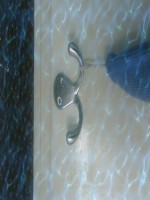
|
@tinydude | |
|
A planet bearing strikingly similar characteristics to Earth and potentially capable of supporting life has been discovered in the Milky Way. Dubbed 'Earth 2.0', Kepler-186f is the closest match to our own planet ever discovered and renews hopes that life in outer space may be a reality. Slightly bigger and colder than Earth, the planet is said to be in the 'Goldilocks zone' because it sits at just the right distance from its star where temperatures allow water, and therefore potentially life, to exist. 'Kepler-186f is the first validated, Earth-size planet in the habitable zone of another star,' said Elisa Quintana of the SETI Institute and Nasas Ames Research Center. 'It has the right size and is at the right distance to have properties similar to our home planet.' |
||
|
30
Replies
3128
Views
0 Favourites
|
||
Page #: 1/2 |

|
@tinydude | 23 April 14 |
|
Dr Quintana is the lead author of a scientific paper detailing the planets discovery, 500 light years from Earth, in this weeks issue of the Science journal. The group of scientists have been keeping watch over 150,000 stars in the universe looking out for slight drops in brightness when a planet passed in front, according to the New York Times. Further analysis of the planet will now take place to determine whether indeed it does hold water. Over 2,000 planets outside our own solar system have been found in the last 20 years but Kepler is particularly good news because the star it orbits is similar to 70 per cent of those in the Milky Way and therefore finding other similar planets is now a real possibility. http://is.gd/PSyvE3 |
||

|
@obi_jon | 23 April 14 |
|
I almost posted this in the spacewatch topic last week.
|
||

|
@mcsnoop | 23 April 14 |
|
if there was already life there and we go there anyway , i think that would make us the aliens invading other planets
|
||

|
@tinydude | 23 April 14 |
|
maybe they're watching us watching them 
|
||

|
@ementalm | 23 April 14 |
 let us go and fk up another planet let us go and fk up another planet
|
||

|
@tinydude | 23 April 14 |
|
@ ementalm - 23.04.14 - 02:43pm  let us go and fk up another planet let us go and fk up another planetthankfully it's too far away for us to damage at the moment 
|
||

|
@silverjx | 23 April 14 |
|
Don't tell Costa or Starbucks
|
||

|
@mcsnoop | 23 April 14 |
|
@ ementalm - 23.04.14 - 02:43pm  let us go and fk up another planet let us go and fk up another planet
|
||

|
@birdy | 23 April 14 |
|
There's a movie about this. 
|
||

|
@purple | 23 April 14 |
|
That's coool 
|
||

|
@tinydude | 23 April 14 |
|
@ birdy - 23.04.14 - 02:47pm There's a movie about this.  which one? |
||

|
@silverjx | 23 April 14 |
|
@ tinydude - 23.04.14 - 02:51pm which one? Avatar |
||

|
@birdy | 23 April 14 |
|
@ tinydude - 23.04.14 - 02:51pm which one? It's called 'Another Earth' |
||

|
@tinydude | 23 April 14 |
|
I was thinking of Prometheus  Is it any good? Is it any good?
|
||

|
@purple | 23 April 14 |
|
@ silverjx - 23.04.14 - 02:52pm Avatar 
|
||

|
@birdy | 23 April 14 |
|
The movie isn't actually about the other earth as such.. it's about what it would mean to have another earth the same as ours, with the same people etc. .. I liked it, doesn't mean you would though. 
|
||

|
@birdy | 23 April 14 |
|
It made me cry. 
|
||

|
@obi_jon | 23 April 14 |
|
Advances in telescope technologies mean we may soon be able to image such exoplanets directly. It is believed that when the new generation scopes are finally put into operation, we will potentially be able to see colour changes on the exoplanets caused by seasonal changes in vegetation. In much the same way that some parts of the earth can be observed to change colour with the seasons, e.g. green grassy areas turning brown in summer. Theoretically, it would even be possible to detect artificial light and heat sources should there be advanced alien civilizations with cities. 
|
||

|
@birdy | 23 April 14 |
|
Bring it on 
|
||

|
@tinydude | 23 April 14 |
|
sweet  proof of e.t. life in my lifetime is what I want proof of e.t. life in my lifetime is what I want 
|
||

 You are not logged in to Prodigits. Please
You are not logged in to Prodigits. Please 


